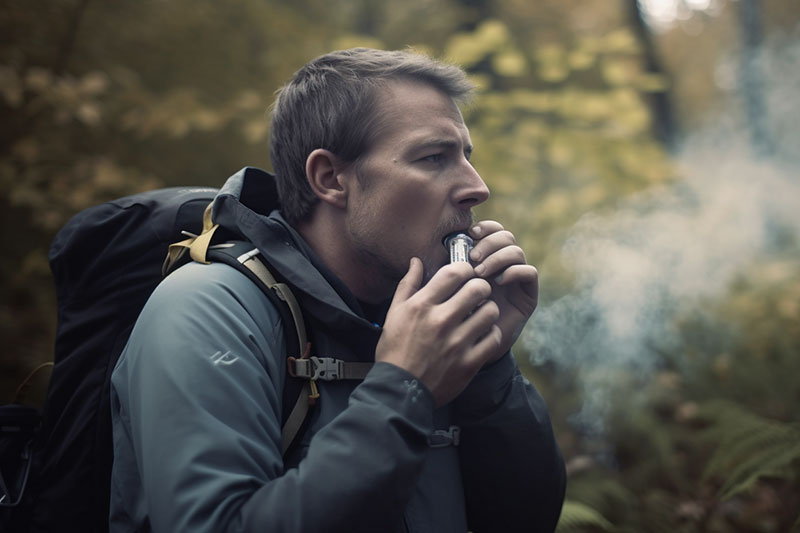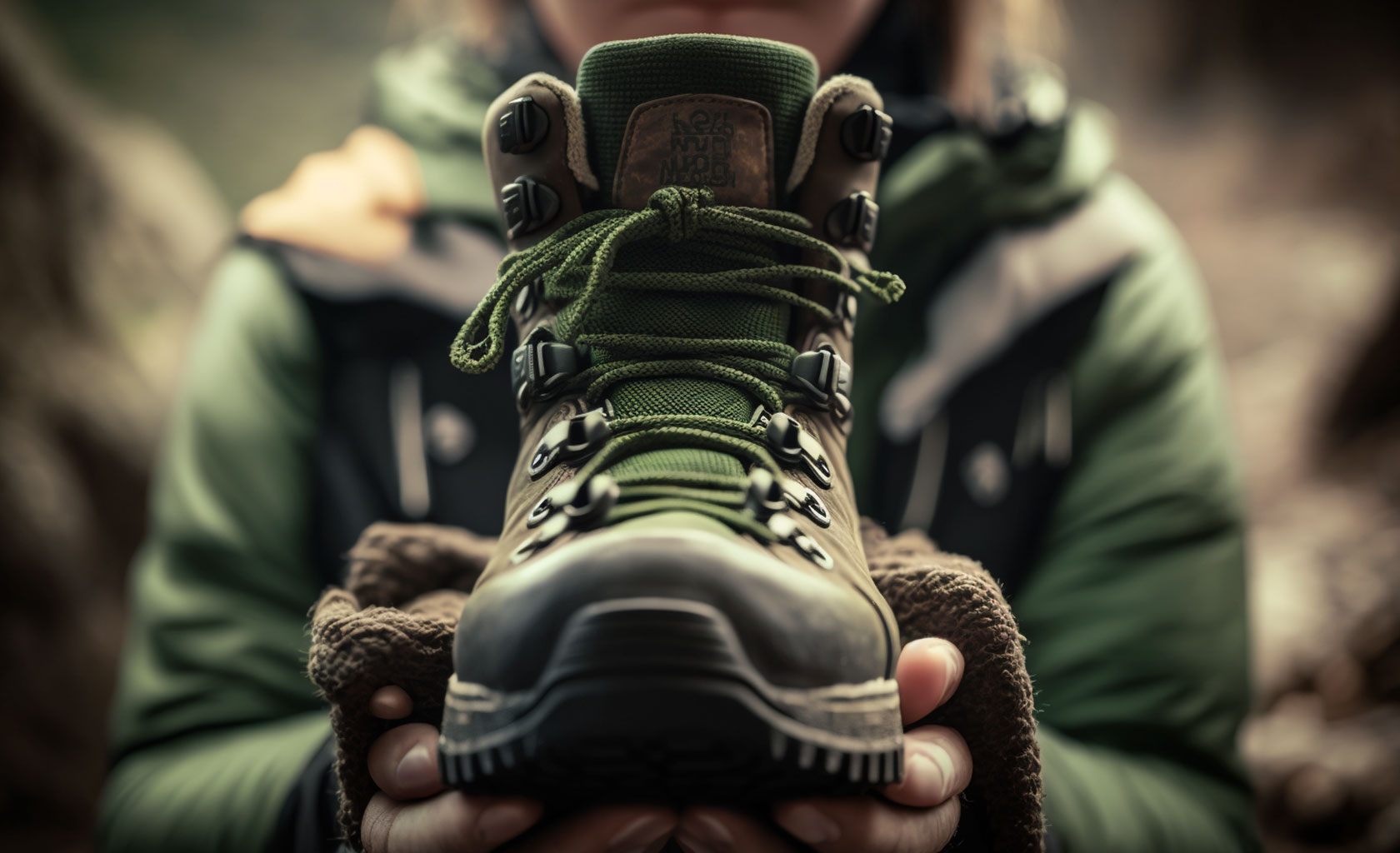There are two reasons for which you might be reading an article about hiking with asthma. One, you have asthma and would like to hike. Two, you know someone who struggles with the condition and would like to help. Either way, you have come to the right place. I am an asthmatic and a hiker. Therefore, I know how it feels to do both – painfully wheeze inside your own home and take calm deep breaths on mountains you conquered on your own feet. Without a helicopter.
I am here to write about how I got from one point to another. Hope it will help.
Disclaimer: I am not an MD. The information presented in this text is based on my own experience and research on asthma. They are not by any means to be construed as medical advice nor a substitute for the opinion of your health care professional.

Asthma – what happens and why
Asthma is when you can’t breathe easily or almost not at all. It is like a 200 lb bag of sand that comes flying out of nowhere to hit you in the chest, knock you down and stay there until it feels like it. A relentless bag of sand with nothing to do but sit on your lungs and apply pressure. Until it kills you.
This is as close as I can get to describe in words the despair of a person suffering an asthmatic attack. But what actually happens inside to cause all these terrifying sensations?
- For reasons currently beyond the full understanding of modern medicine, the air passages in your lungs (bronchial tubes) and tinier tubes these divide into (bronchioles) start swelling. This is inflammation. It makes air passages tight.
- As the inflammation continues, specific cells in your lungs start producing mucus. This makes air passages become even tighter. It becomes difficult to inhale.
- The air you manage to breathe in gets to the little air sacks at the end of the bronchioles. It gets trapped there, due to all the swelling and mucus. Carbon dioxide and oxygen exchange cannot be performed properly. Your body lacks oxygen (hypoxia) and you cannot breathe out.
And, as you are having trouble performing the basic function needed to keep you alive while a low oxygen level makes you restless and confused, people around you say something like “Stay calm it will pass”. Yeah, right.
And now I am here telling you that you can go hiking with asthma. Yeah, right once more.
Hiking with asthma – is it even possible
”Did you know that there are people with asthma who run marathons?”
This is the first sentence my pulmonologist told me when I was diagnosed with the condition. It was 3 days after my first asthma attack. I was 18 at the time, unable to walk, sleep or eat properly. As it turned out, this simple question was more than half of my recovery. It soothed me and prepared me for what was coming. So, I now give it to you, to repeat as a mantra – did you know that there are people with asthma who run marathons?
If it is possible to have asthma and run a marathon, why would hiking with asthma be a problem?

Hiking with asthma – benefits
Science has spoken and the answer is yes. Hiking is good for asthma. And here is how.
According to a scientific article titled Hiking – A Low-Cost, Accessible Intervention to Promote Health Benefits, published in 2018 in the American Journal of Lifestyle Medicine, immediate benefits of hiking include ”decreased blood pressure, decreased stress levels, enhanced immune system functioning, and restored attention”.
Three out of four of the quoted benefits of hiking are in direct connection with asthma.
- Decreased blood pressure – High blood pressure can make asthma attacks more frequent. At the same time, asthma, as an inflammatory condition, can lead to high blood pressure. More details on the relation between the two can be found in this scientific report.
- Better immune system functioning – Asthma is not an autoimmune disease. However, narrowing of the airway passages and increased production of mucus are an (over) reaction of your immune system. So, the two are most closely connected.
- Decreased stress levels – Stress hormones have a major impact on asthma. Adrenaline can cause the smooth muscles surrounding the airways to contract or tighten (bronchoconstriction). This means narrowing of the airway passages. Cortisol normally helps reduce inflammation. However, prolonged high levels of cortisol (chronic stress) can weaken the immune system. This can make individuals more susceptible to respiratory infections or allergens that trigger asthma symptoms. For more details on the matter, check the report named Stress and Inflammation in Exacerbations of Asthma.
So, scientifically speaking, hiking helps relieve the conditions that influence asthma directly. Therefore, it is up to you and your lungs to agree on how to start walking.
Now, let’s move on to this more individual perspective.
How to hike with asthma
This part of the article will be about what an asthmatic person can do, on an individual level, to enable and prepare oneself to start hiking with asthma. It is about what I have done so far, with success.It all comes down to 3 things – medications, food and persistence.

The best medical advice I ever got
“Take your medications and start a diet.“
Let’s go back 20 years from now to the same medical checkup when I was first diagnosed with asthma. I was the one barely breathing but it was my mother who was barely alive. Fear overwhelmed her. In essence, she needed the assurance that I was not going to die. And she got it.
What I got was the above-mentioned advice -take your medication and start a diet.
So, mom had some grocery shopping to do. I had to forget some foods ever existed.
Hiking with asthma - food regime

Unprocessed food
“Eat exclusively unprocessed or minimally processed foods for 3 months following the diagnosis/attack“.
The asthma diet prescribed by my doctor was very simple. Too simple even, to the point that it becomes complicated.
In essence, I was to avoid all fast foods and anything that comes in a plastic package or a can and has a long expiration date. This means saying goodbye to hard cheese, for example, not to mention hams, bacon, tuna cans or even bread and cereals. It is difficult I know. We are all hooked on added salts, sugars and taste enhancers. However, the goal of the regime is to unburden metabolism, improve immune system functioning and reduce inflammatory response to the extent possible. This helps asthma management greatly.
The list below is an example of what I ate and why. The list is non-exhaustive of course, as there are many other unprocessed foods you can include in your regime. For more info, look for studies on anti-inflammatory diets.
Foods that help asthma management
| Unprocessed food | What it contains | How it helps asthma management |
| Fruits | ||
| Apples | vitamin C and antioxidants | support lung function and reduce inflammation in the airways |
| Oranges | vitamin C | bolster the immune system and may reduce the risk of respiratory infections |
| Berries | antioxidants, including flavonoids and anthocyanins | combat inflammation and oxidative stress |
| Bananas | vitamin B6 and fiber | contribute to lung health and overall well-being in individuals with asthma |
| Vegetables | ||
| Spinach | vitamins A, C, E, K, minerals, and antioxidants | supports lung health and helps reduce airway inflammation |
| Broccoli | vitamin C, antioxidants, and anti-inflammatory compounds | positively impacts asthma symptoms |
| Carrots | beta-carotene | maintain healthy lung tissues and potentially alleviate asthma symptoms |
| Kale | vitamins A, C, and K, and antioxidants | promotes lung function and may aid in asthma management |
| Whole grains | ||
| Quinoa | protein, fiber, and essential nutrients | contributes to overall health |
| Brown rice | fiber, vitamins, and minerals | supports immune function and lung health |
| Oats | beta-glucans and antioxidants | reduce airway inflammation and enhance asthma management |
| Legumes | ||
| Lentils | protein and fiber | support respiratory health |
| Chickpeas | vitamins, minerals, and antioxidants | reduce airway inflammation |
| Black beans | fiber and antioxidants | help in maintaining lung health and mitigating asthma symptoms |
| Nuts and seeds | ||
| Almond | healthy fats and antioxidants | have anti-inflammatory effects |
| Chia seeds | omega-3 fatty acids and antioxidants | reduce inflammation |
| Flax seeds | omega-3 fatty acids and lignans | anti-inflammatory properties |
| Fatty fish | ||
| Salmon | omega-3 fatty acids | anti-inflammatory properties |
| Diary | ||
| Plain yoghurt and kefir | probiotics | healthy gut microbiome positively impacts immune function |
| Herbs and spices | ||
| Tumeric | curcumin | anti-inflammatory properties |
| Ginger | gingerols | anti-inflammatory and anti-allergic properties |
| Other | ||
| Extra virgin olive oil | monounsaturated fats and antioxidants | anti-inflammatory effects |
| Honey | flavonoids and polyphenols | reduces inflammation and fights free radicals |
| Green tea | polyphenols and antioxidants | anti-inflammatory properties |
Processed foods and asthma - related risks

To sum up, these substances harm you directly. All of them (and many other similar) are found in foods that comprise the so-called Western diet. This includes highly processed meats and cereals, snacks, soft drinks, packaged foods, fried foods, alcohol, etc.
Scientific evidence suggests that the Western diet is in direct correlation with inflammation, obesity, cardiovascular diseases, immune system function and asthma. So, in order to stay healthy or improve your condition and go hiking with asthma you simply have to avoid processed foods to the extent possible. Period.

Hiking with asthma – step-by-step guide
Once you have balanced your medications and your diet, you are free to start hiking with asthma.
Fear of asthma attack occurrence is huge, I know. Yet, a life lived in fear is a life half lived. So, here is how to overcome the fear and start hiking with asthma as freely as possible.
- Always take your medications with you
Irrespective of what triggers your asthma and how long it has been since your last attack, bringing your medications with you is a must. Better safe than sorry.
- Rest before hiking
People who suffer from asthma have a tendency to get tired easily. So, try to start your first hikes when you actually feel good physically. Good night’s rest is paramount.
- Pace yourself properly
In the context of hiking with asthma, this means 2 things – paying attention to how you feel while hiking and knowing when to decrease the intensity in order to calm your breath and be able to continue. This is determined on an individual level. The best advice I can give you here is to start small. Take shorter hikes with frequent rests.
- Don’t change altitudes too quickly
Start small but start low too. You will be able to track uphill and take higher altitudes too, but it will take time. In the beginning, settle for even terrain.
- Count your breaths
This has to do with pacing. Synchronize your steps with your breaths and try to breathe through your nose. It would be great if you could, for example, make 2 steps while inhaling and 4 while exhaling. This mimics breathing exercises. 2 steps per exhale are also ok. In any case, find the rhythm that does not tire you.
Final advice
From one asthmatic person to another – do not rush. Not ever. The time will come for the marathons and mountains, but you have to be patient and persistent in your patience. Remember, those who persist are the ones who prevail.
PS. Try not to start your hiking in cold weather. Breathing in cold air may narrow and dry air passages. And always dress properly. Advice on how to do this is given here.
- https://my.clevelandclinic.org/health/articles/11323-sulfite-sensitivity#:~:text=Articles%20%2F%20Sulfite%20Sensitivity-,Sulfite%20Sensitivity,as%20a%20variety%20of%20medications.
- https://www.ncbi.nlm.nih.gov/pmc/articles/PMC5938543/
- https://pubmed.ncbi.nlm.nih.gov/16713393/
- https://www.ncbi.nlm.nih.gov/pmc/articles/PMC9471313/








